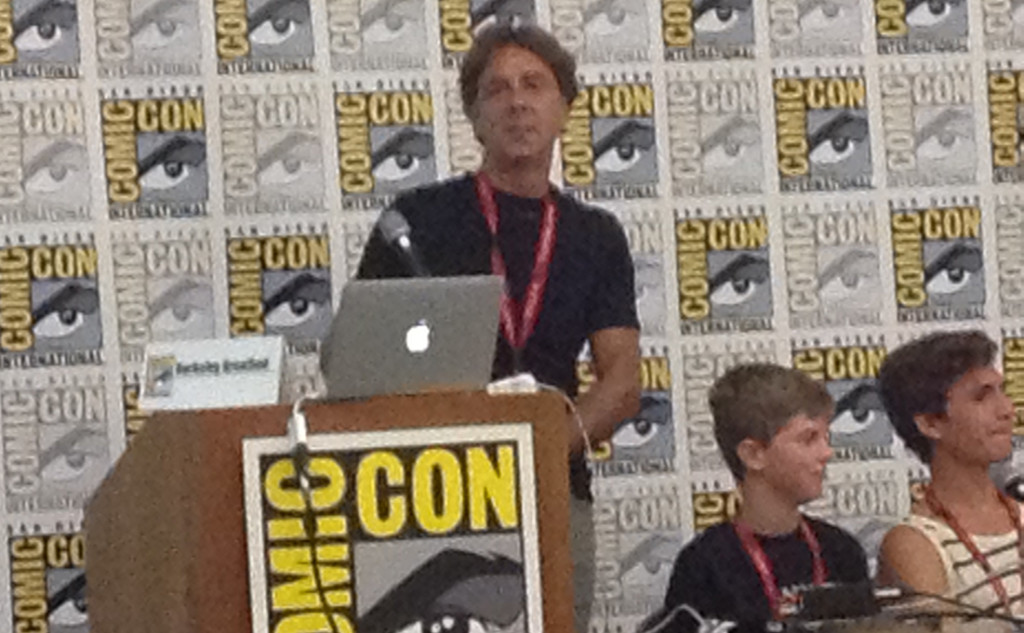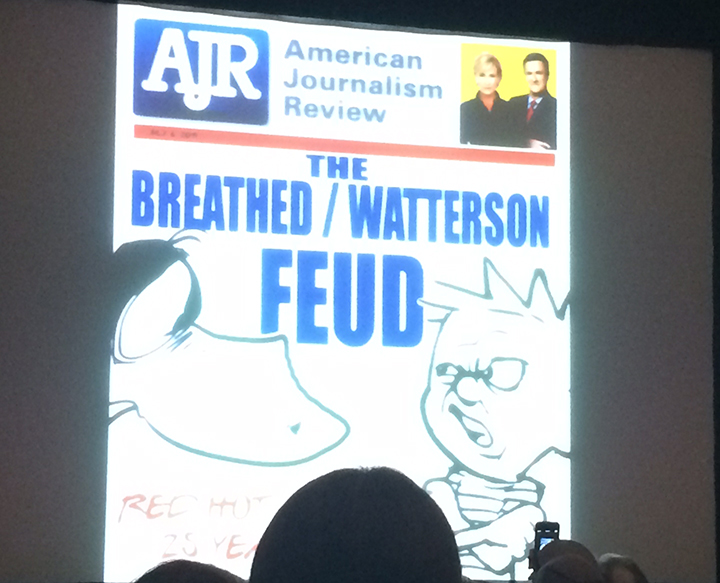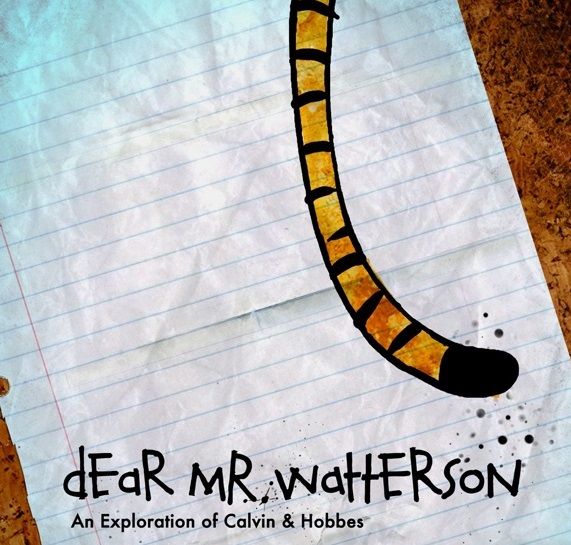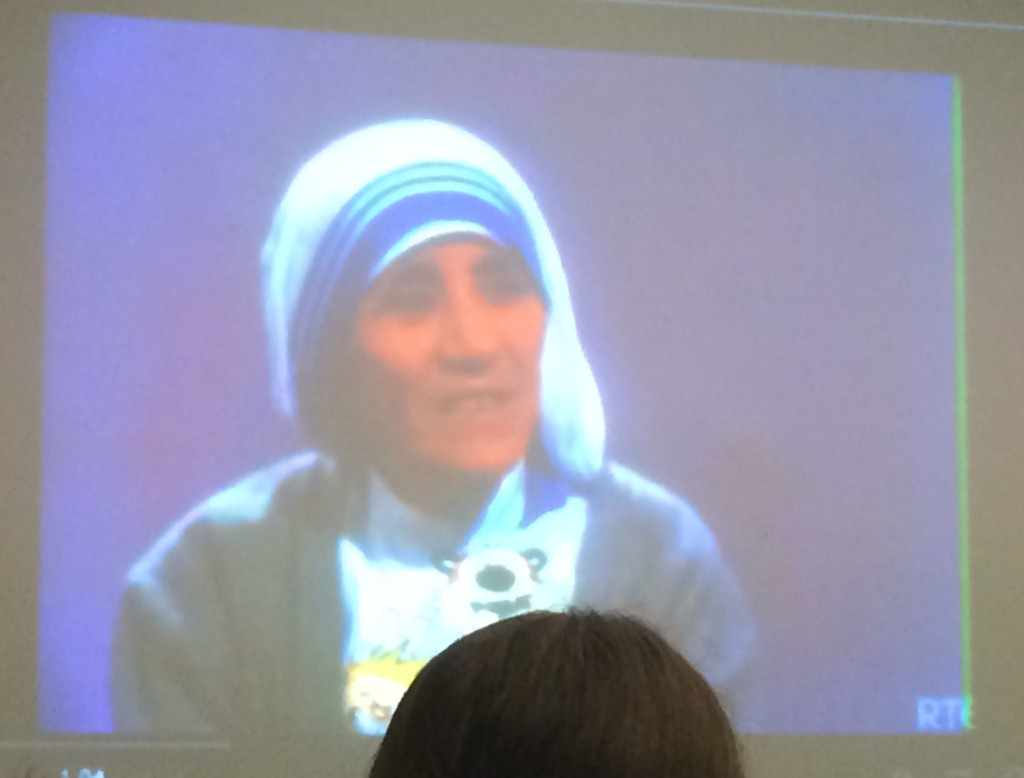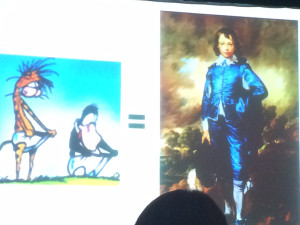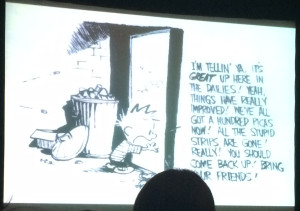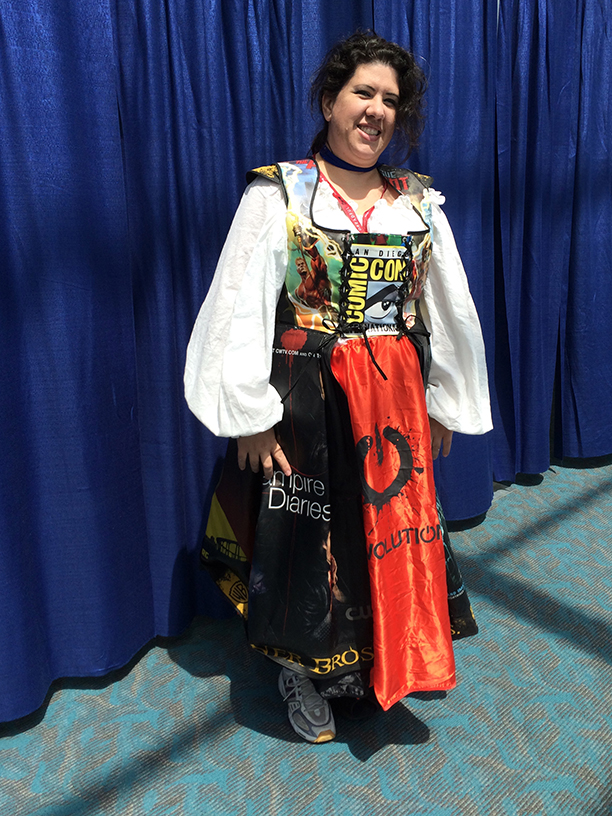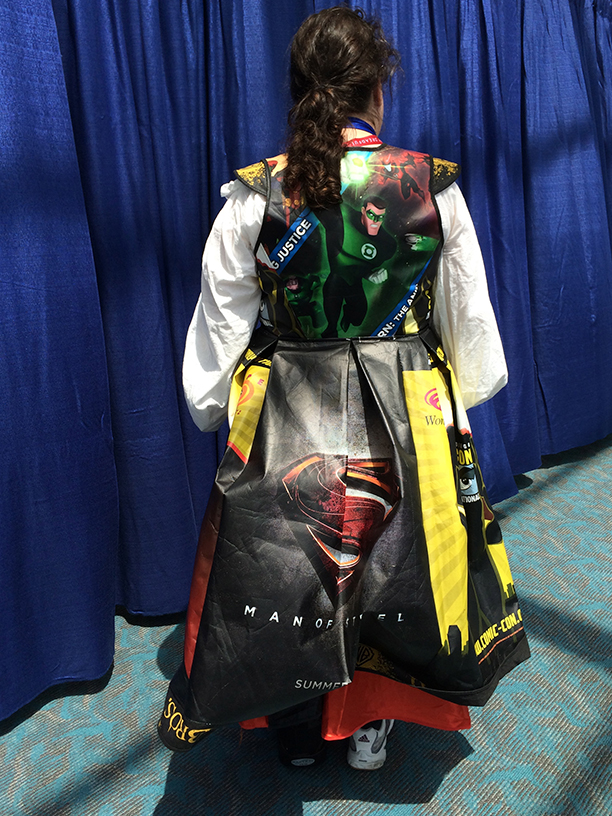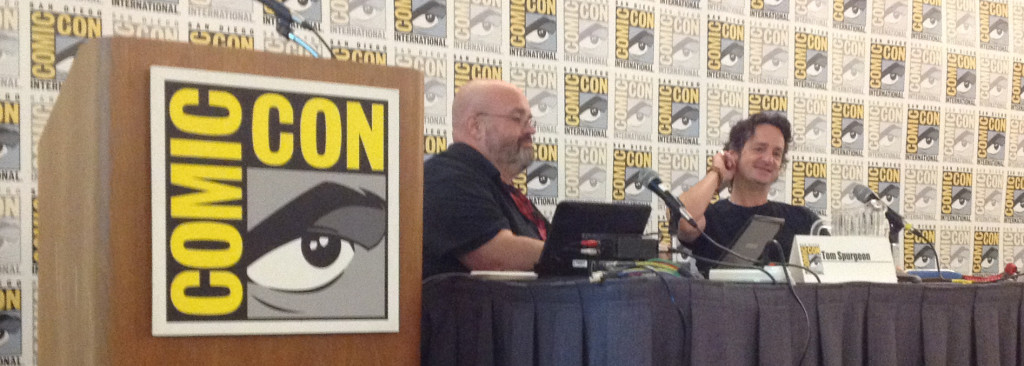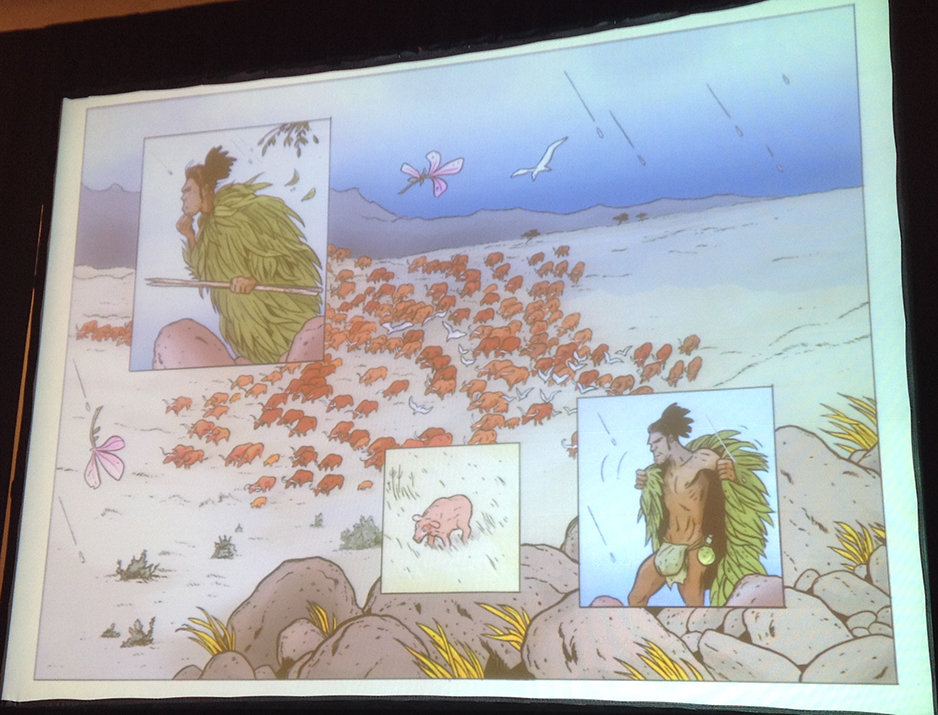Hello, and welcome to today’s tiny sliver of what Comic-Con is like. In each of my day’s reports, I’m giving you but one person’s glimpse into this vast enterprise, the attendance of which tends to be around 50,000 people. If you were here, your focus might be different than mine. Or if you did attend this year’s Comic-Con, I’m sure I saw things that you didn’t – and vice-versa.
I missed the earliest panels I’d planned to attend today because I was still writing up yesterday’s experience. Fortunately, today’s will be more brief….
Berkeley Breathed: The Last Comic-Con Panel!
To a packed room, Breathed offered a satirical presentation, addressing his correspondence with Bill Watterson, marketing, and his (possibly imagined) film projects. Breathed’s deadpan delivery kept the line between satire and truth deliberately vague, but subtle tonal shifts usually let you know when he was kidding. Usually. It was great, quick, and impossible to summarize.
Breathed began by saying (tongue in cheek), “My heart is heavy for my close personal friend Bill Watterson.” And so, he added, “I thought I’d take the opportunity to shoot down the rumors.” He then proceeded to invent the rumors he was going to shoot down, as well as spread some mock-scurrilous rumors about Mr. Watterson himself.
Of the documentary, Looking for Mr. Watterson, Breathed said “They never found him. Â They had celebrities, Cathy Guisewite,…” and then he put up this slide which (in case it’s too blurry) is Mother Theresa wearing a Calvin & Hobbes t-shirt.
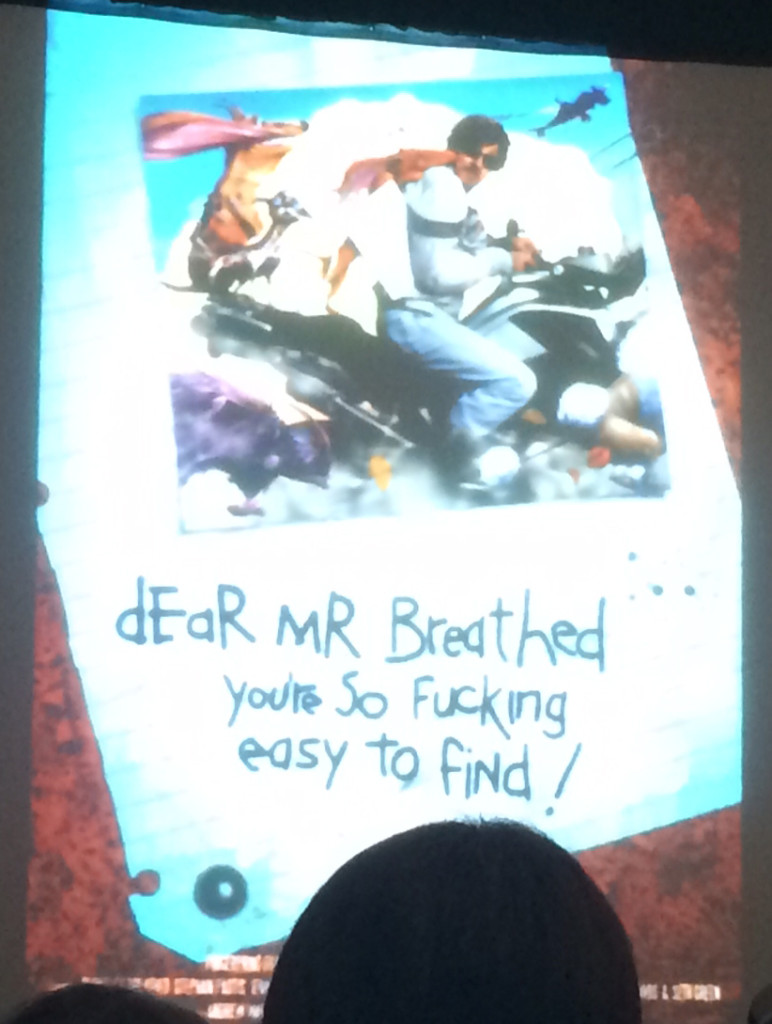 But of course they never found Mr. Watterson himself. Berke Breathed himself was interviewed, and “was stupid enough to mention a few critical letters” that Watterson had written to him. This, Breathed suspects, may be a source of the friction between himself and Watterson. But, he assures us, “I take my business just as seriously as bill does.” And so, he said, he’d like to announce his new Kickstarter project, Dear Mr. Breathed You’re So Fucking Easy to Find! In that film, Breathed promised “to set the record straight,” and added, “I can compete with Bill’s film on every level.”
But of course they never found Mr. Watterson himself. Berke Breathed himself was interviewed, and “was stupid enough to mention a few critical letters” that Watterson had written to him. This, Breathed suspects, may be a source of the friction between himself and Watterson. But, he assures us, “I take my business just as seriously as bill does.” And so, he said, he’d like to announce his new Kickstarter project, Dear Mr. Breathed You’re So Fucking Easy to Find! In that film, Breathed promised “to set the record straight,” and added, “I can compete with Bill’s film on every level.”
Breathed showed us glimpses of his film projects, though it wasn’t entirely clear which of these were actual film projects and which were invented for the purpose of Breathed’s talk. The films included
- Flawed Dogs.
- Something About C-Mo, in which a dog learns to read and spell – with Cheetos.
The big difference between Breathed and Watterson (says Breathed) is that Breathed agreed to do some merchandising, but Watterson refused. Letters sent from Watterson to Breathed included satirical cartoons at the bottom, playfully mocking Breathed. But, Breathed explains, “I was forced into merchandise with a gun to my head. I gave it all to… – no, I didn’t give it all to charity.”
Because he’s sure Bill Watterson wouldn’t mind, he wanted to share with us “a few selections from his new life.” Breathed stressed, “this isn’t payback. Â I just have a few photos, and I don’t think he’d mind me sharing.” One photo is Watterson standing between sexy young women –Â though it’s clear that Watterson’s face has just been digitally added (it’s from that same black-and-white photo from Watterson’s days as an editorial cartoonist).
Breathed concludes by saying that he will be signing at the IDW booth.
Questions from audience…
Will there be reprints of Academia Waltz?
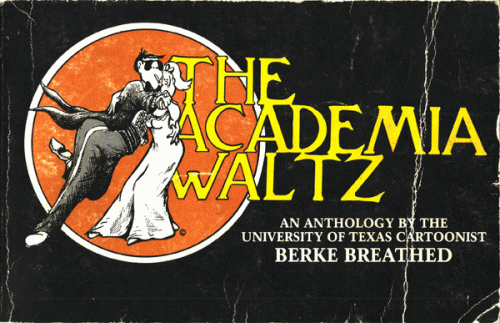 Breathed replies, “Yes, actually. The contract is on my desk right now.” He doesn’t really think they should be, but IDW really wants to do it.
Breathed replies, “Yes, actually. The contract is on my desk right now.” He doesn’t really think they should be, but IDW really wants to do it.
Another audience member calls out “They [Academia Waltz strips] got me through law school at UT!”
Breathed asks, “Do you think they should be reprinted and sold?”
The same audience member responds, “Well, maybe I’m remembering them better than they were.”
Will there ever be an Opus movie?
The Opus movie, Breathed says, has been held up by Weinstein brothers. “The last note I got from Bob Weinstein said ‘Does the penguin have to talk?’” There was a collective groan from the audience. So, Breathed said, “Will there ever be a movie? It’s a huge roll of the dice. And I’d need to have more control than I have now.”
Is there anybody right now who you’re reading?
Breathed responded, “I’m not reading the comic pages anymore.” He said, “I got into comics in a backdoor way. I didn’t come at like Bill did.” And in the Q+A Breathed spoke seriously of his admiration for Watterson, who was so dedicated to the craft of making cartoons. Unlike Watterson, “I wanted to make films,” Breathed said. Again underscoring the purity of Watterson’s dedication to his art, Breathed claimed, “Charles Schulz was the richest entertainer – bigger than Spielberg, bigger than George Lucas. Bill Watterson walked away from that kind of money. He’s a hero. Â He’s doing it right.”
Questions about other publications, other forthcoming work…
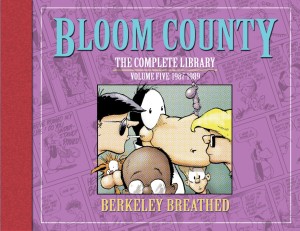 Breathed says, “Everything I’ve ever drawn will be published by IDW.” The Bloom County books did not include all of the Bloom County strips. IDW’s complete collection will include everything, which, Breathed says, is a good thing because those old strips have started to disintegrate. That’s due in part to the way he stored them – under his python’s cage. One thing pythons do a lot, he says, is pee. So, turning to the IDW representative there, he said, “that’s what those stains are. I did tell you that, right?”
Breathed says, “Everything I’ve ever drawn will be published by IDW.” The Bloom County books did not include all of the Bloom County strips. IDW’s complete collection will include everything, which, Breathed says, is a good thing because those old strips have started to disintegrate. That’s due in part to the way he stored them – under his python’s cage. One thing pythons do a lot, he says, is pee. So, turning to the IDW representative there, he said, “that’s what those stains are. I did tell you that, right?”
He says he would not do Bloom County in the current media landscape. At the time he did it, “Bloom County was fun because I had no competition. You had Johnny Carson, you had Saturday Night Live. Â And yes, you had Doonesbury, which was great. But his tone was so lofty, that it [comics] was just waiting for a smart-ass like me.”
So, we won’t see more comics from Breathed, but “I still love movies. Those are my passion. And so that’s where you’ll see me.”
Breathed concludes by saying, “I’d love some more drawings from Bill, with his drawings on the bottom, cutting me to death.”
CBLDF: Banned Comics!
Moderator Charles Brownstein led a discussion on banned books, featuring panelists Carol Tilley, Jeff Smith, and Gene Luen Yang. And, while I don’t know that there was “new” information (to people who follow these discussion), hearing the panelists on this subject was worthwhile, and these sorts of panels are vital for helping to create awareness. Indeed, if such panels aren’t held at every Comic-Con, they should be.
My sense is that the rising number of challenges to Bone may have motivated the timing of this session. As Jeff Smith said of this past year’s Banned Book list, “Fifty Shades of Gray was number 5, and I was number 10.” Smith explained, “Bone has been challenged for a number of years now, but this was just the first time it made the top 10.”
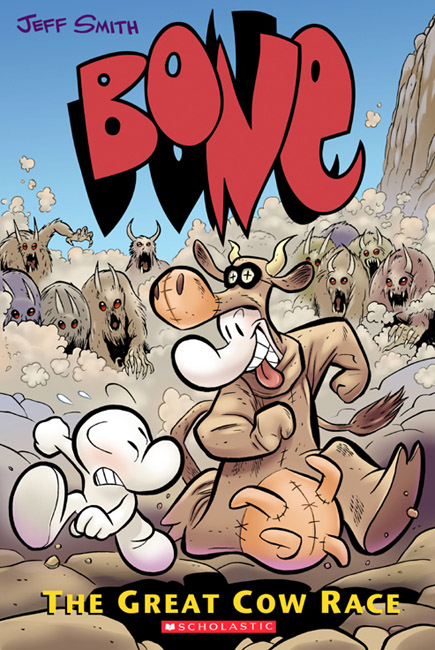 Why? Smith said, “Bone has been challenged for sexual situations, political viewpoint, racism and violence.” Carol Tilley added, “And smoking.” To which Smith responded, “And smoking. And drinking and gambling. And racism.” Gene Luen Yang asked, “Racism? How do they get racism?” Smith responded, “I don’t know. I don’t get to talk to these people. These comics are almost like Rorschach Tests that say more about the people making the challenge than about reading the books. Â I think they see their kid reading the books, and they don’t see what came before or what came after.”
Why? Smith said, “Bone has been challenged for sexual situations, political viewpoint, racism and violence.” Carol Tilley added, “And smoking.” To which Smith responded, “And smoking. And drinking and gambling. And racism.” Gene Luen Yang asked, “Racism? How do they get racism?” Smith responded, “I don’t know. I don’t get to talk to these people. These comics are almost like Rorschach Tests that say more about the people making the challenge than about reading the books. Â I think they see their kid reading the books, and they don’t see what came before or what came after.”
Brownstein noted that “The challenges that occur in comics are along the same lines of those that occur in [non-comic] books.” So, he asked, “Why, when we have freedom of speech?” (Since I live in Kansas, where university employees do not have freedom of speech, I thought, “How nice that Mr. Brownstein lives in a place where there’s freedom of speech. I guess he must not work for a corporation that prohibits freedom of speech either.”) Tilley answered Bronstein’s question: “One of the most frequent reasons for a challenge is this vague reason called ‘inappropriate for age.’” She then paraphrased Dorothy Broderick: “It’s not just conservatives who want to censor materials. The only difference between liberals and conservatives and censorship is what they want to keep their children away from.” This is something I often tell my students when I teach about censorship –Â as one must do when teaching children’s literature, young adult literature, graphic novels….
Yang weighed in: “I am a parent. I have four kids. I’m really stunned that Bone is on the top 10 list. Because I’m fairly prudish. And I can’t imagine parents who are more prudish than me.” He then explained why freedom of speech is important. “First, there’s an individualism that’s at the root of America, but … reading should happen within the community, within the family. Â So there should be material in there that makes people want to have a discussion. Â Second, America is a collection of subcultures. And what makes that exist is freedom. So, you have to have a basic respect for freedom. So, those are the things that guide my work as a teacher, as a parent, as a creator.”
Addressing the question of audience, Smith explained, “Bone was not originally intended as a children’s book.” He just wrote it for other comics fans, really. At that time, “there were no kids reading comic books back then, pretty much.” So, “I was writing Bone as a pastiche of funny animal books and Lord of the Rings books.” For this reason, he said, “I certainly didn’t censor myself because I was writing for 30-year-olds.” The audience of Bone transformed it into a book for young people: “Readers turned Bone into a children’s book. Â It was not me.” In any case, he says, he still finds it surprising that it would be a target of censors: “We used to joke that Bone could be banned some day because it’s the most squeaky-clean comic.”
 Speaking about challenges to his work, Yang began “On the internet, I think people are just mean. When American Born Chinese came out, MySpace – remember MySpace? – chose it as the book of the month. And there was this long discussion of how American Born Chinese was racist and a manifestation of my self-hatred.” However, these readers missed the point. “The whole point of Cousin Chin-kee was so that I could cut his head off at the end.” Yang also admitted that he abridges his own work when he reads it to his children (he has four): “When I read American Born Chinese to my kids, I only read the Monkey King parts. But my eldest, my son, snuck off and read the whole thing. But that’s OK. Because he can talk about it with me, his dad. You have to be realistic. You can’t police everything that they watch. They’re going to encounter things that are out of their comfort zone.” I found it interesting that he limits his own children’s reading (including self-editing his own work), but also seems OK when they push back against these limits and read things he’s asked them not to. Broadly speaking, it’s a metaphor for parents’ efforts to protect their children from the various danger they will surely face – well-intentioned, even necessary, but also impossible to sustain.
Speaking about challenges to his work, Yang began “On the internet, I think people are just mean. When American Born Chinese came out, MySpace – remember MySpace? – chose it as the book of the month. And there was this long discussion of how American Born Chinese was racist and a manifestation of my self-hatred.” However, these readers missed the point. “The whole point of Cousin Chin-kee was so that I could cut his head off at the end.” Yang also admitted that he abridges his own work when he reads it to his children (he has four): “When I read American Born Chinese to my kids, I only read the Monkey King parts. But my eldest, my son, snuck off and read the whole thing. But that’s OK. Because he can talk about it with me, his dad. You have to be realistic. You can’t police everything that they watch. They’re going to encounter things that are out of their comfort zone.” I found it interesting that he limits his own children’s reading (including self-editing his own work), but also seems OK when they push back against these limits and read things he’s asked them not to. Broadly speaking, it’s a metaphor for parents’ efforts to protect their children from the various danger they will surely face – well-intentioned, even necessary, but also impossible to sustain.
Charles Brownstein: I wasn’t allowed to read comic books when I was growing up, which of course is why I work in them.
Gene Luen Yang: Me too. I wasn’t either!
Underscoring the humility with which he applies rules in his own household, Yang said, “The thing with parenting is from the moment they’re born until the moment they leave your house, there’s just a constant breakdown of authority in your house. Â That’s just the way it works. Â That’s what they sign up for.”
Back on the subject of freedom of speech, Tilley said, “Even though it may sound a little silly, a 3-year-old and a 93-year-old have the same intellectual rights.” And that’s an excellent point, as is Dorothy Broderick’s point (quoted by Tilley) that “Libraries have something to offend everyone.” Amplifying that idea, Tilley added, “Libraries should have something to offend everyone”
Comic-Con Personified!
Chatting with Scott McCloud & Ivy Ratafia (Scott’s wife) after the “Banned Comics” panel, Ivy noticed a young woman who had made herself an entire dress out of the giant Comic-Con bags you get when you register. (Last year’s – and perhaps other years’ – also had a cape that unfurled down the back. You can see her using some of that fabric, too.) Very creative!
The front:
The back:
Spotlight on Willie Ito
In case Willie Ito’s name is unfamiliar to you, the conference program offers a useful professional biography:
With nearly 60 years as an animation artist, Comic-Con special guest Willie Ito has done it all. He worked at Disney on Lady and the Tramp‘s spaghetti scene with mentor Iwao Takamoto and on One Froggy Evening and What’s Opera Doc at Warner Bros’ famed Termite Terrace under Chuck Jones’ direction. He went on to The Beany and Cecil Show with Bob Clampett and then Hanna Barbera for the beginnings of The Flintstones, The Jetsons, and many other cartoons. Ito has great stories and experiences to share. After HB he went to Disney Consumer Products and spearheaded implementation of collectibles and licensed products worldwide. He has also designed comic books, comic strips, coloring books, and more. Join animation expert Leslie Combemale of ArtInsights for a spotlight on Willie’s life, including the part of his childhood spent in a Japanese internment camp that inspired his most recent venture, a series of children’s picture books based on the experience.
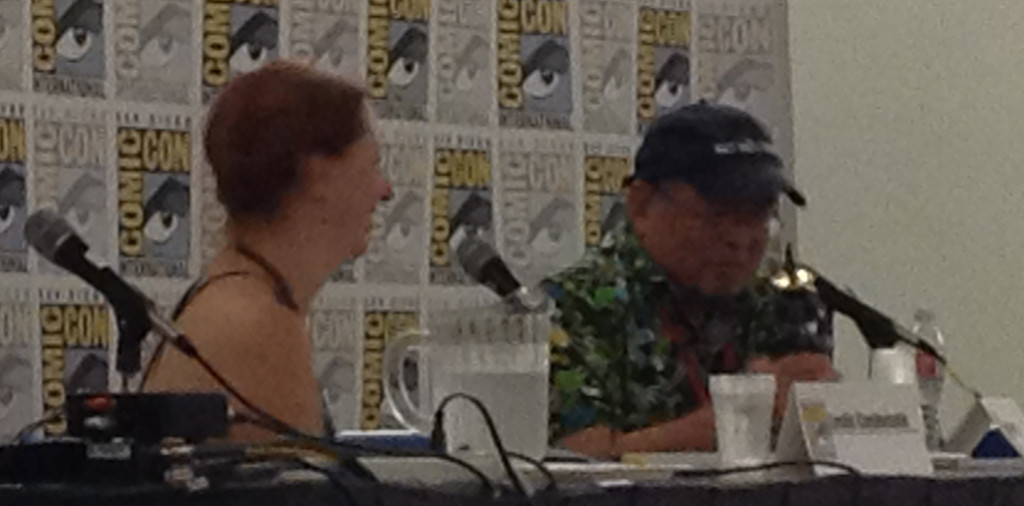
At the very beginning of the panel, a representative from Comic-Con presented Willie Ito with an Inkpot Award, and he was touched by the recognition.
Being at this panel was like listening to a memoir in progress. As I sat there, I kept thinking: Is someone recording this? Willie Ito needs to write his autobiography. And if he doesn’t write it, then someone else should!
Beyond the fact that he worked at pretty much every major animation studio, Ito – who is an American of Japanese descent – also lived in California during World War II. I did not manage to transcribe everything he said, but it’s a heck of a story.
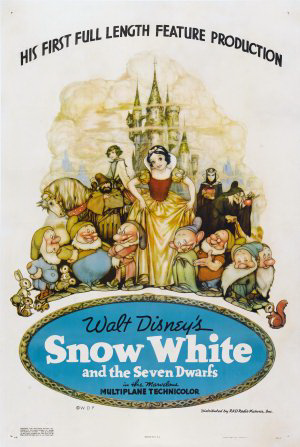 Leslie Combemale began the conversation: “When you were really little, you wanted to work for Disney.” Willie Ito answered, “I grew up in San Francisco in an enclave called Japantown. … On the outskirs of Japantown was a neighborhood theatre. Â This was 1939. Â We made a habit of going to the movies once, maybe twice, a week. Â This was before television. Â I used to listen to the radio a lot – Buck Rogers, Lone Ranger, and all those classic shows.”
Leslie Combemale began the conversation: “When you were really little, you wanted to work for Disney.” Willie Ito answered, “I grew up in San Francisco in an enclave called Japantown. … On the outskirs of Japantown was a neighborhood theatre. Â This was 1939. Â We made a habit of going to the movies once, maybe twice, a week. Â This was before television. Â I used to listen to the radio a lot – Buck Rogers, Lone Ranger, and all those classic shows.”
Ito then recalled seeing the Seven Dwarfs, singing, in color (in Disney’s Snow White and the Seven Dwarfs): “And I said that’s what I want to be! Â Not one of the Seven Dwarves, but an animator.”
He also enjoyed comics: “I was a big fan of the Walt Disney Comics & Stories, Looney Tunes [comic books]. Â I was basically into funny animals. Â And along with the comic books, I would get coloring books. Â They used to have for a time these books called the Big Little Books, and they were reprints from the newspaper.” He said, “Every Sunday, I would go downstairs, and there was this big, thick, San Francisco Examiner. Â I would go straight to the comics.”
Combemale asked, “What was the first thing you remember drawing?” Ito replied, “I remember there was a coloring book, and I remember tracing it, and I thought, ‘Well, that’s even better than Walt Disney!’ Of course, back then, I thought Walt Disney drew it all.”
Ito recalled one morning, going off to the beach, accompanied by his uncle and the woman would become his aunt. They were very focused on each other, and quite happy to let him play on the beach on his own. Later that afternoon, the fog rolled in, and they decided to call it a day. As they approached the city limits, they saw that a checkpoint had been set up. They didn’t know why. Officers were asking for proof that people entering the city of San Francisco actually lived in San Francisco. Finally, Ito recalled, “we got into the city, and then we saw the headlines: WAR! I never knew what war meant.  So, I asked my Uncle ‘What does “war” mean?’ Pearl Harbor had been attacked.”
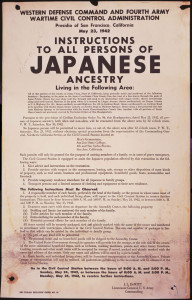 At that point, “rumors immediately started swirling around about what our fate would be. Â Finally, President Franklin Delano Roosevelt signed Order 9066. Â We were going to be evacuated into internment camps, in 6 months. You couldn’t take everything with you – only what you need.”
At that point, “rumors immediately started swirling around about what our fate would be. Â Finally, President Franklin Delano Roosevelt signed Order 9066. Â We were going to be evacuated into internment camps, in 6 months. You couldn’t take everything with you – only what you need.”
Combemale, alluding to Nazi Germany said, “That sounds like somewhere else, at the same time.”
Ito replied, “Mmm-hmm. Â My first thought was ‘I can’t take my comic book collection!’” He realized, too, that he would have to leave behind his Dopey bank –Â that is, a piggy-bank featuring the likeness of Dopey from Snow White and the Seven Dwarfs.
Another memory from that time: “I remember coming home one day and there were FBI agents there, looking for anything that might be considered contraband. Â They were tall, 6-footers.” Ito explains, “One of the crazy things they did was confiscate the lawn-mowers because the Japanese gardeners are going to mow arrows” that would point Japanese pilots towards key targets. He chuckled as he said this –Â indeed, describing the bigotry he faced, he often chuckled. I was struck by his ability to speak of these events without any apparent malice. I expect that, had this happened to me, I would have been bitter. Perhaps he was bitter at one point, and learned to let go of bitterness?
Describing the internment camps themselves, Ito said, “They put us up in stables. Â They didn’t really have time to build barracks. Â For the first, early arrivals, we were literally in horse stables. Â So, the internees would come, and this was where they stayed.” When they arrived, the internees asked, “Where are the mattresses?” Â The guards said, “You see those white bags?” Ito explained that there were “stacks of white bags.” So, the guards said, “Fill them up with hay.” (They were, literally living in stables.) Â So, Ito says, “if you had allergies….”
Combemale asked, “How long were you there?” Ito said that they were in the stables for six months before they moved into the barracks. He added, again with wryness (rather than bitterness), “We were considered a security risk to the government, because we could signal to the Japanese ships or something.”
The story was riveting, and would, as I say, make for a great memoir or film. On the experience of being in the camps themselves, Ito said, “The rumor in our communities was ‘What’s going to happen if Japan wins the war or the U.S. wins the war? Â We’re just going to be lined up and executed.’” Again, he was able to speak of this calmly, without bitterness towards his captors.
Combemale asked, “Did it keep you sane to be doing drawings while you were there?” Ito didn’t have paper, but they did have Sears catalogues from which they would order what they needed. So, Ito told us, “I would take the expired catalogues, and draw on the margins.” Ever the aspiring animator, Ito made flipbooks in the margins of the Sears catalogue.
To conclude the internment narrative, Ito reports that when he got back to his house after the war, his Dopey bank was still there!
What was really wonderful about this conversation is that Combemale had the judgment to simply let Ito talk, recount his experience. She’s an excellent listener –Â an ideal quality for an interviewer to have.
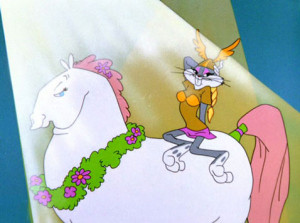 Combemale: You were also in Chuck Jones’s unit on What’s Opera, Doc? You said he was an interesting person to work with.
Combemale: You were also in Chuck Jones’s unit on What’s Opera, Doc? You said he was an interesting person to work with.
Willie Ito: I admired him from afar. One time, we were watching a pencil test, and, at the end, I sort of blurted out, “Charles M. Jones, Super-Genius.” And Chuck sort of looked at me like “… hmmmm….”
Ito recalls another moment when he was watching a cartoon with Jones: “I would be watching a Friz Freling cartoon, laughing with tears rolling down my face. Â And Chuck Jones would be looking at me, glaring.”
Ito was hired by Walt Disney Productions for the “Lady” unit (i.e., the unit working on Lady and the Tramp). Â He “reported to Milt Kahl – one of the 9 Old Men! And Iwao Takamoto was there!” And I didn’t manage to capture the full history of Ito’s working career –Â at a certain point, I was just listening and not taking notes. (Sorry!)
Ito worked a year at Bob Clampett. He said, “I want you to design all my characters– and they were all puppets.” This was a great opportunity for Ito because “I got to work in design, layout, etc.  So, after that, going to Hanna Barbera, I felt like a veteran. I could do it all!”
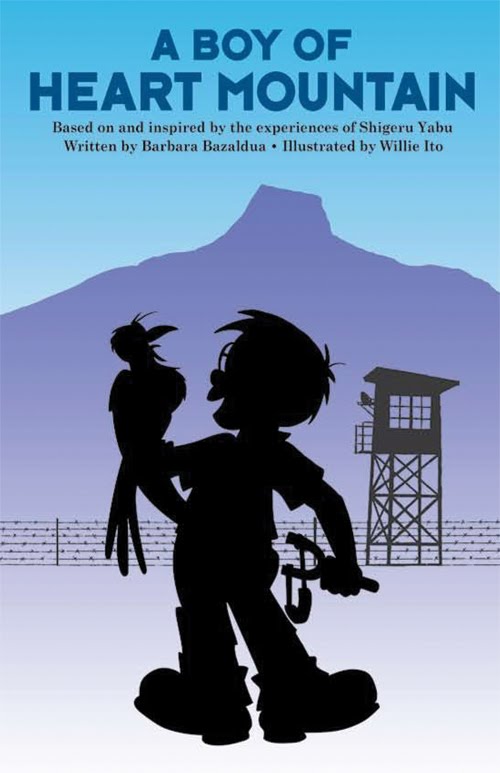 Ito would go on to spend 14 years at Hanna Barbera. At the time he went, he told Chuck Jones that he was going to take that job. Jones advised him against it because it was television, and those studios wouldn’t last. He said that staying at Warner Brothers would provide steady work because they would always be making these cartoon shorts. Yet, Ito recalled, “while I was there [at Hanna Barbera], Warner Bros. closed down!”
Ito would go on to spend 14 years at Hanna Barbera. At the time he went, he told Chuck Jones that he was going to take that job. Jones advised him against it because it was television, and those studios wouldn’t last. He said that staying at Warner Brothers would provide steady work because they would always be making these cartoon shorts. Yet, Ito recalled, “while I was there [at Hanna Barbera], Warner Bros. closed down!”
The panel did not get to cover as much of Ito’s career, but the focus on his earlier life was riveting. If you’re interested in learning more about it, Ito has a book called A Boy of Heart Mountain, which “educates children about sending an entire group of people to camps, for a while.”
Spotlight on Jeff Smith
As the program says, “Comic-Con special guest Jeff Smith discusses his foray into the world of online comics with his new title TUKI: Save the Humans, as well as the 10th anniversary of Scholastic’s color version of Bone. Moderated by Tom Spurgeon (The Comics Reporter).”
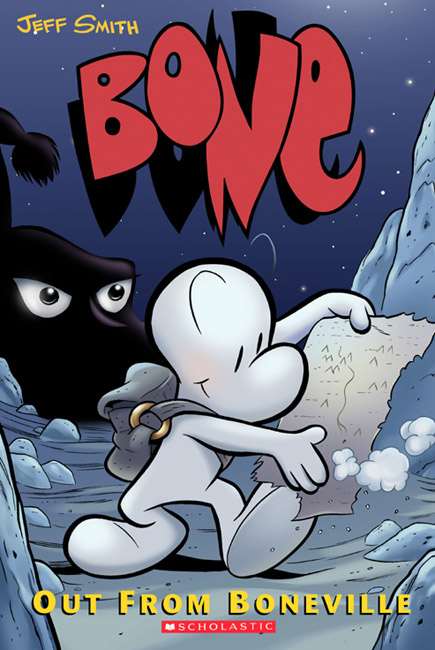 Tom Spurgeon did a great job of moderating this discussion with Jeff Smith, which began with the announcement of a new edition of Bone Vol. 1, commemorating the tenth anniversary of Scholastic Graphix. It’s a new special edition with, as Smith says, “eight new pages, including the rat creatures’ ode to quiche.  And other drawings from scholastic artists.  It comes out in Spring of 2015.  That’s just the first step of the rollout of things we’re doing next year.”
Tom Spurgeon did a great job of moderating this discussion with Jeff Smith, which began with the announcement of a new edition of Bone Vol. 1, commemorating the tenth anniversary of Scholastic Graphix. It’s a new special edition with, as Smith says, “eight new pages, including the rat creatures’ ode to quiche.  And other drawings from scholastic artists.  It comes out in Spring of 2015.  That’s just the first step of the rollout of things we’re doing next year.”
Tom Spurgeon: Doing the whole series over again?
Jeff Smith: No, just the first volume.
Tom Spurgeon: Do you think in terms of legacy formats at this point?
Jeff Smith: Yes. IDW now wants to do a legacy edition of all nine books. I’m like really? At 100 bucks a pop? Oh, all right. [Laughs.] No, I’m not going to do that.  At first, I thought they wanted me to add a new section to it.  And I thought maybe I could add a scene during winter?  I realized that I couldn’t get my mind back into that space.  And the book was done.  I shouldn’t do any more to it.
(A note on my reporting. I’m capturing the contours of the conversation, but not every last word. So, what you see is as close to a direct quotation as I was able to transcribe, but it’s not the same as, say, reading the transcription of a recorded event.)
 I liked Smith’s practical approach to what he’s known for. Rather than (as some artists might) chafe under being known primarily for Bone, he said, “Bone is going to be — I’m never going to get out from under that shadow. So, I think I need to enjoy that.  Whereever I go, I’m the Bone guy.  I’m Jeff ‘Bone’ Smith.” And you could see that he does enjoy it. After the panel, for example, he kindly consented to a photo with a fan and her Fone Bone plush doll.  The Cartoon Books booth had plush dolls of all three Bones – as well as his copies of Bone, and newer works, such as RASL, and the first issue of TUKI.
I liked Smith’s practical approach to what he’s known for. Rather than (as some artists might) chafe under being known primarily for Bone, he said, “Bone is going to be — I’m never going to get out from under that shadow. So, I think I need to enjoy that.  Whereever I go, I’m the Bone guy.  I’m Jeff ‘Bone’ Smith.” And you could see that he does enjoy it. After the panel, for example, he kindly consented to a photo with a fan and her Fone Bone plush doll.  The Cartoon Books booth had plush dolls of all three Bones – as well as his copies of Bone, and newer works, such as RASL, and the first issue of TUKI.
Acknowledging the difference between these three projects, Smith said, “I wanted to get TUKI going while RASL was underway, so that people could see that all three had the same strand of DNA running through them.”  Smith spoke of enjoying drawing TUKI after RASL.
Jeff Smith: I don’t have draw buildings and cars, as in RASL. I can draw streams and mountains, which is much more natural to me. Â With Bone, I had an Encylopedia Britannica, a leather-bound set. I did all of Bone with Encyclopedia Britannica. Â When I was doing Shazam, I would go to the public library and get books out on New York City. That was the last time I went to the library.
Tom Spurgeon: There’s a moral there, but it’s an uncomfortable one.
He’s also enjoying TUKI because, as he says, “I did want to do humor again.  There was not much humor in my noir [RASL].”
Indulging us comics nerds in the audience, Spurgeon and Smith had a conversation about how Smith designs a page. Â How does he know to put those three inset boxes, of varying sizes, at those specific places on the page? Â How does he do his layouts? Â Smith responded, “I experimented with it, did several versions.” Â Presumably, people read the top left panel first (because we read from left to right), but, Smith explained, “I put the flower and the bird up there to keep your eye up there.” The idea is that Tuki is hunting, and he sees the one animal that has strayed from the herd (in the middle panel).
Looking at Tuki, Spurgeon said, “You’re one of our great character designers,” and noted Smith’s many distinct characters – Fone Bone, Thorn, the rat creatures, Gran’ma Ben, Rasl, and now Tuki – who, in Smith’s new graphic novel, is the first human. “What is it you look for in a character?”  Describing Tuki, Smith said, “I worked with him for a while. He’s African, so he’s going to be black. He’s also not human. He’s Homo Erectus,” which (as I understand it) is the phase in evolution just before Homo Sapiens.
Tom Spurgeon: Are you drawing sketches?
Jeff Smith: There are a few pages in my files: What does Tuki look like? They didn’t have clothes, then. So, what do you do? They didn’t wear loincloths. I realized that our ancestors did carry things with them…. So, that allowed me to create something to cover up his junk. [Laughs]
Tom Spurgeon: How precious are you with your tools?
Jeff Smith: [Joking] Excuse me?
Tom Spurgeon: ToolS.
 Smith also talked about his research for the character, noting, “Some people think Homo Erectus couldn’t talk, but until Homo Erectus there was no voice box. So… it’s debatable.” Â On his artistic style for this work, he noted that “RASL had some kind of Jack Kirby faces,” whereas TUKIÂ “is going to be more Sergio Aragones.”
Smith also talked about his research for the character, noting, “Some people think Homo Erectus couldn’t talk, but until Homo Erectus there was no voice box. So… it’s debatable.” Â On his artistic style for this work, he noted that “RASL had some kind of Jack Kirby faces,” whereas TUKIÂ “is going to be more Sergio Aragones.”
Tom Spurgeon: How is it to be an influential cartoonist?
Jeff Smith: Well, it’s very flattering. I like it.
Tom Spurgeon: As I recall, you didn’t expect it.
Jeff Smith: No, no one expects it… Â I guess, in a way, I feel like it’s kind of a stage you reach.
Smith also talked about, in Bone‘s early issues, hiding the fact that Bone was a fantasy, because he figured that if he was clear that it was, then that would be the end. No one would read it. So, instead, he spent the first third of the book inviting readers to get to know the characters, and like the characters, so that when he revealed that it was fantasy, they’d stick with it. But he eventually had to admit that it was fantasy: “There was a certain point where I couldn’t hide it any more. I had to come out. I had to come out of the closet!” [Laughs]
The Highlight of My Day – and my Comic-Con
After the panel, I introduced myself to Jeff Smith, and we walked down to his booth. I explained that I was the guy who co-wrote that article on Bone and Moby-Dick (for which he kindly supplied images), and that I’m working on Barnaby for Fantagraphics with Eric. He said, “Oh! You’re Phil!” And he said that he really loved the article – that it was great, that we really got it (Bone). This made my day. He went on to say that this article was one reason he agreed to write a foreword for the third Barnaby book – and that he’d just been talking to Eric about this.  This made my day again. And my Comic-Con.
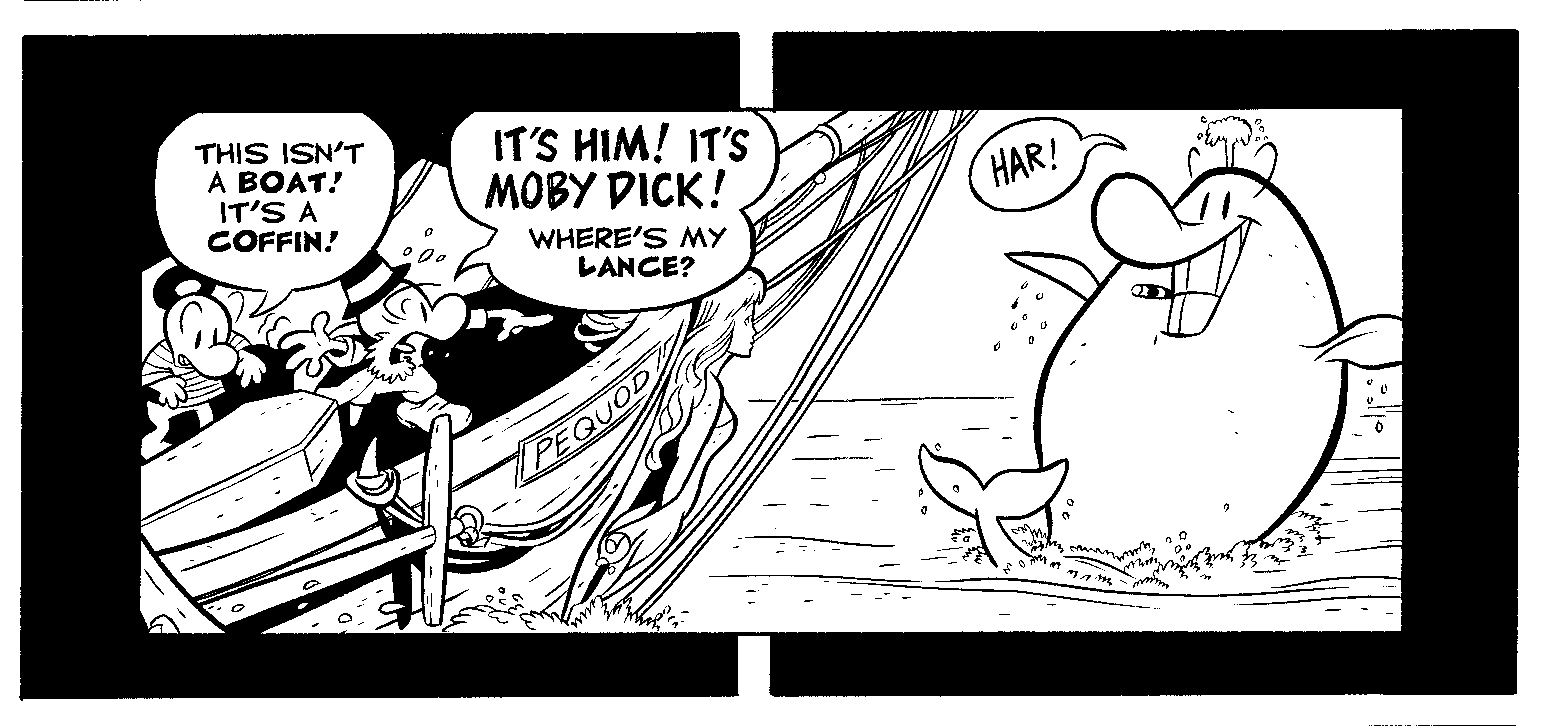
It’s also an example of the unpredictability of what you write. My friend Jennifer Hughes and I wrote this article because we thought it would be fun to co-write an article, and I thought it’d be fun to re-read Moby-Dick, fun to re-read Bone, and I’d always wanted to write something on Bone.  It’s not part of a larger project for either of us.  It was just fun to do.  So.  Thanks, Jennifer!  And thanks, Jeff!
Note: nearly all photos from the Berkeley Breathed event are courtesy of Karin Westman.
Comic-Con 2014:
Comic-Con 2013:

